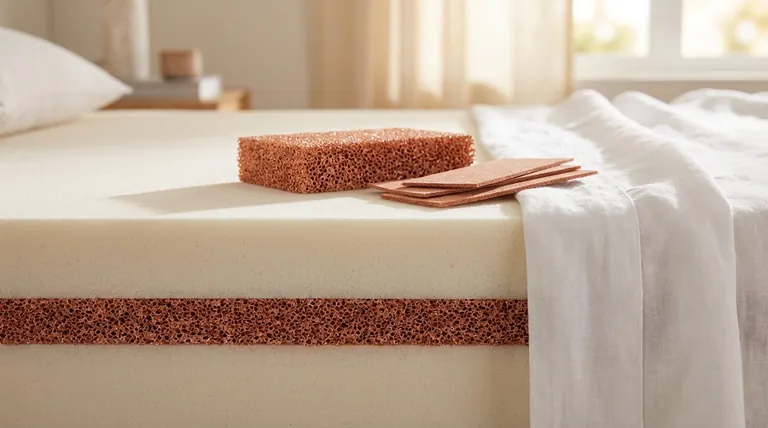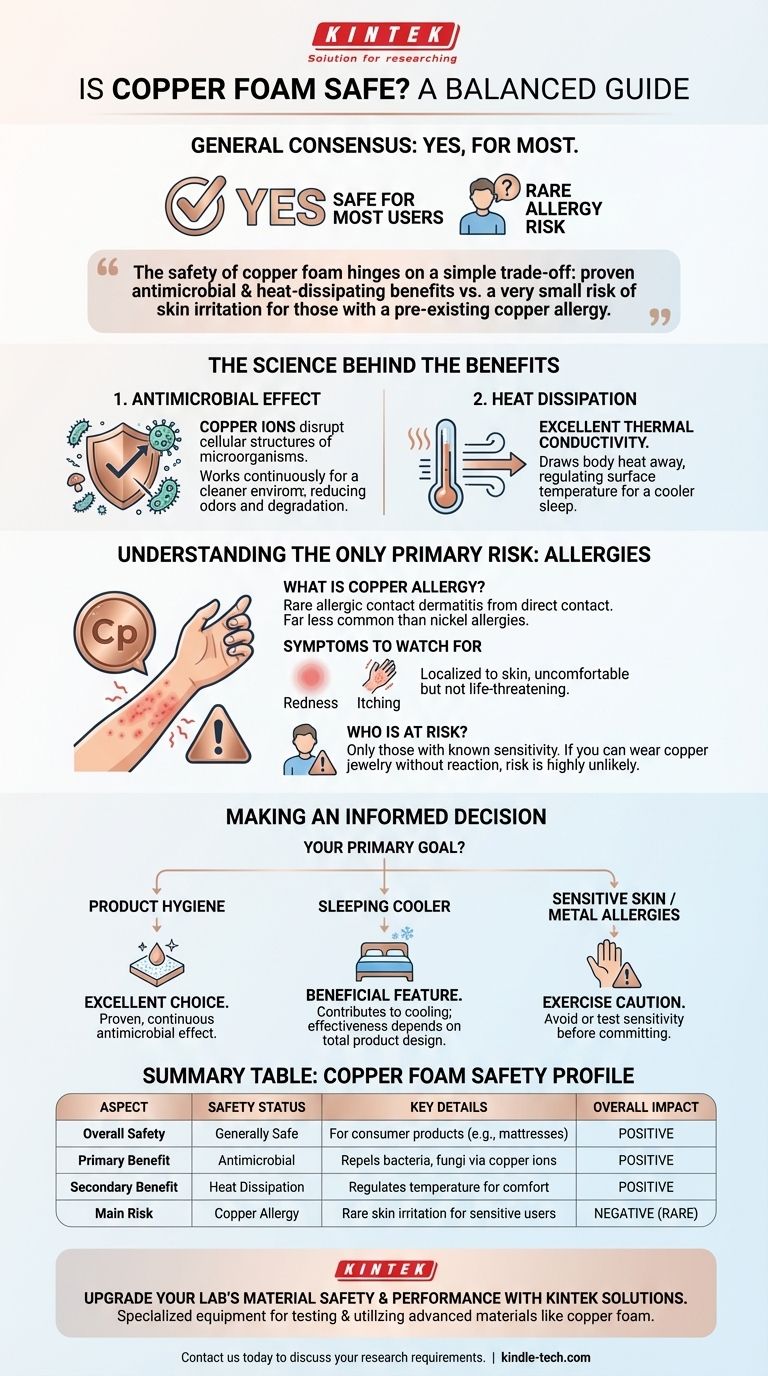In most cases, yes. Copper foam is generally considered safe for consumer products and is often used in items like mattresses and pillows for its unique properties. Its primary benefits are a natural antimicrobial effect and enhanced heat dissipation, while the only significant risk is for individuals with a specific, and relatively uncommon, copper allergy.
The safety of copper foam hinges on a simple trade-off: you gain proven antimicrobial and heat-dissipating benefits in exchange for a very small risk of skin irritation, which is only a concern for those with a pre-existing copper allergy or sensitivity.

The Science Behind Copper Foam's Properties
To understand its safety profile, we first need to understand how copper functions when infused into a material like foam. The benefits are not based on harsh chemicals but on the inherent physical properties of the metal itself.
How Copper Achieves its Antimicrobial Effect
Copper has a well-documented ability to repel and neutralize bacteria, fungi, and other microbes. This occurs because copper ions are naturally disruptive to the cellular structures of these microorganisms.
This antimicrobial quality is an intrinsic property of the metal. It works continuously to create a cleaner environment within the product, helping to reduce odors and degradation over time.
The Role of Thermal Conductivity
Copper is an excellent conductor of heat. When it is infused into foam, it creates a pathway for body heat to be drawn away from you and dispersed throughout the material.
This process helps to regulate the surface temperature, which can contribute to a cooler and more comfortable sleep experience, especially for those who tend to sleep hot.
Understanding the Primary Safety Concern: Allergies
For the vast majority of the population, copper foam poses no health risk. The conversation around safety almost exclusively revolves around allergic contact dermatitis.
What is a Copper Allergy?
A copper allergy is a type of skin reaction that occurs when someone with a sensitivity comes into direct contact with the metal. It is far less common than other metal allergies, such as those to nickel.
Symptoms to Watch For
The symptoms are typically localized to the skin and may include redness, itching, or a rash in the area of contact. These reactions are uncomfortable but are not considered life-threatening.
Who is Genuinely at Risk?
The only group that needs to exercise caution are those with a known or suspected sensitivity to copper. If you can wear copper jewelry without a reaction, it is highly unlikely you would be affected by a copper-infused product.
Making an Informed Decision
To determine if a copper-infused product is the right choice, align the technology's benefits with your specific goals.
- If your primary focus is product hygiene: A copper-infused product is an excellent choice, as its antimicrobial properties are proven and work continuously to keep the material cleaner.
- If your primary focus is sleeping cooler: View copper as a beneficial feature that contributes to cooling, but its overall effectiveness will also depend on the product's total design, including foam density and fabric covers.
- If you have sensitive skin or known metal allergies: It is wise to exercise caution and either avoid copper-infused products or test your sensitivity before committing to a purchase.
Ultimately, copper foam is a safe and functional material for most people, offering tangible benefits for product cleanliness and temperature regulation.
Summary Table:
| Aspect | Safety Status | Key Details |
|---|---|---|
| Overall Safety | Generally safe for most users | Considered safe for consumer products like mattresses and pillows |
| Primary Benefit | Antimicrobial effect | Naturally repels bacteria, fungi, and microbes through copper ions |
| Secondary Benefit | Heat dissipation | Excellent thermal conductivity helps regulate temperature for comfort |
| Main Risk | Copper allergy | Rare skin irritation (redness, itching) only for those with sensitivity |
Upgrade your lab's material safety and performance with KINTEK solutions.
Our specialized lab equipment and consumables help you test and utilize advanced materials like copper foam safely and effectively. Whether you're researching antimicrobial properties or thermal conductivity, KINTEK provides the precision tools you need.
Contact us today to discuss how our products can support your laboratory's specific requirements and enhance your research outcomes.
Visual Guide

Related Products
- Copper Foam
- High Purity Zinc Foil for Battery Lab Applications
- High-Purity Titanium Foil and Sheet for Industrial Applications
- Isostatic Molding Pressing Molds for Lab
- Vacuum Bellows for Efficient Connection and Stable Vacuum in High-Performance Systems
People Also Ask
- What role does convection play in heat transfer? Understanding Heat Movement in Fluids
- Can I solder copper to copper without flux? The Critical Role of Flux for a Strong Bond
- What are the characteristics of copper foam? Unlock High-Performance Thermal and Electrical Solutions
- What are the available sizes and thicknesses for copper foam? Optimize Your Thermal and Filtration Performance
- What is copper foam used for? A Guide to Its High-Performance Thermal and Energy Applications



















